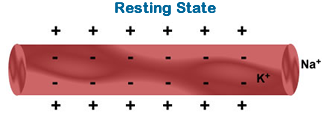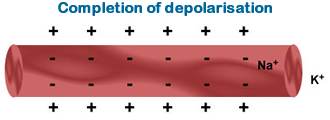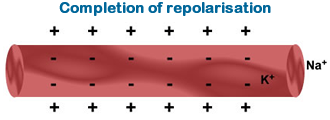Biochemistry of the heart
The cardiac cells are surrounded with a solution containing both positively charged and negatively charged ions. The way in which this is affected by depolarisation and repolarisation is explained below.
The intracellular space contains a high concentration of potassium ions and a low concentration of sodium ions. The extra cellular space contains high concentrations of sodium and chloride ions and low concentrations of potassium ion.
The electrical charge inside the cell changes due to the cyclical shift of these ions.
The process of depolarisation and repolarisation is shown:
Resting state

Electrical charge inside the cell is more negative and the outside of the cell in more positive.
Beginning of depolarisation

Completion of depolarisation

Beginning of repolarisation

Completion of repolarisation
